There is a group of muscles in the thigh called the quadriceps, which help you flex your hip, lift the thigh and extend the knee. One of these muscles is called the rectus femoris, which is the longest, but weakest of these muscles. It is therefore easily injured, often causing a strain, which can cause you to limp because of an inflamed tendon at the hip joint.
What Causes a Rectus Femoris Strain?
The rectus femoris muscle is attached to two joints by tendons, one at the hip and the other at the knee. The tendon in front of the hip is commonly injured, as well as the belly of the muscle in the thigh.
An injury called hip flexor or rectus femoris strain is common during sports such as football and soccer. It usually results from a forceful movement like sudden sprinting or kicking a ball. It can even be worse when the foot strikes against another player while kicking.
Incorrect stretching of the thighs can also cause injury to the rectus femoris tendon. Stretching elongates muscle fibers, but you do not want to stretch the tendons, which will weaken its fibers and make them vulnerable to injury. Weakening of the tendon is a slow process which can occur due to overstretching for years, developing an injury. With proper stretching, the muscle is pulled and elongated, instead of the tendon.
Other activities that could cause rectus femoris strain include: power walking, running, cycling, climbing, swimming, and even wearing high heels.
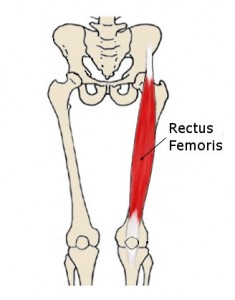
How Do I Know If I Have a Rectus Femoris Strain?
Symptoms
If you have a strain, you will feel a sharp pain at the hip when doing sudden forceful activities. Afterwards, you may also have difficulty lifting the knee.
Physical Examination
- Examination by observation and touch
Physical examination of the injured area may show bruising and swelling. Postural abnormalities may be noted on standing and walking. On touch, the muscle may be tense, painful, and in severe cases, a gap at the location of the rectus femoris muscle might be felt.
- Range of motion

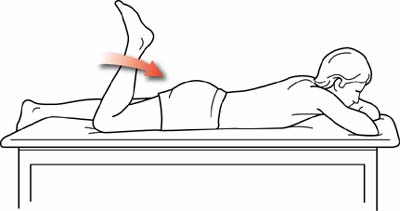
On testing for range of motion at the hip and knee joints, pain and tightness of the muscle may be felt. Pain on hip extension and knee flexion suggests a rectus femoris strain.
- Resisted muscle tests
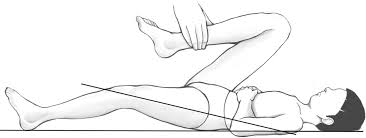
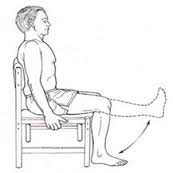
These tests involve moving the leg against resistance for both hip flexion and knee extension. If there is pain in both, or if one leg is weaker than the other, then a strain may be suspected.
Other Tests
Your doctor may request for x-rays to determine if you pulled a fragment of bone off your hip, which is common among young athletes who are still growing. Other imaging exams may include an MRI of your hip to identify the tendon involved and the extent of injury. This will give your doctor an idea about how long it might take for you to recover and return to normal activity.
How to Deal With a Rectus Femoris Strain
Home Care
Self-care for a strain includes the RICE approach:
- Rest. You must avoid strenuous activities that can cause discomfort, pain, or swelling. However, you must also do some light activity to prevent deconditioning.
- Ice. Apply an ice pack to the affected area immediately. Or, you can use an ice slush bath for 15-20 minutes and repeat the process every 2-3 hours for a few days following the injury.
- Compression. Compression of the muscle with an elastic bandage will help reduce swelling. Do not wrap your thigh too tightly because it might affect circulation. Begin wrapping from below the knee up the hip. Loosen the compression wrap if pain increases, or if the area becomes numb. Remove the compression if swelling occurs below the wrapped part.
- Elevation. Elevating the injured area above the level of the heart will help reduce swelling. This is recommended especially at night, to allow gravity to reduce swelling.
In addition, you can also take over-the-counter medications for pain and inflammation such as ibuprofen and acetaminophen.
Pressure Treatment
Pressure treatment on the trigger points of the rectus femoris muscle can help improve your range of motion. To do this, follow the steps below:
- Sit on a chair.
- Place your elbow on the leg a few inches above your knee cap.
- Gently press at various points into the muscle beginning at the knee up to the pelvis. Trigger points are usually found near the hip. These trigger points hurt when pressed, but some parts that hurt may not be a trigger point. Feel for discrete nodules or areas of swelling, which may range in size from a tiny pea to a large walnut.
- Apply gentle pressure on these areas until pain subsides.
- For the main trigger point just below the muscle attachment at the hip, it is easier to have someone else help apply pressure. To self-treat, lean against a tennis ball on the wall or floor. Remember to use only gentle but firm pressure. After your pressure treatment, muscle stretching is recommended.
Stretching
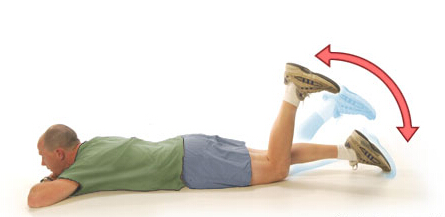
After treating the muscle for pain and inflammation caused by the rectus femoris strain, you must start gradual stretching for at least once per hour for several days. This should not hurt. Stretch the muscle and hold for 3-5 seconds. Do this three times on both legs.
Do the knee flexion exercise by pulling your heel toward the buttock without twisting the knee. Repeat, but pull the heel towards the other buttock. Keep your hip straight or extended. If your hip is flexed, you will only stretch the vastus muscles, but not the rectus femoris.
You can gently begin to use the injured leg after 2 days. Gradually you will see progressive improvement in your joints’ ability to support weight be able to move without much pain. Mild to moderate rectus femoris strain usually heal in 3-6 weeks. Consult a physical therapist to help you to maximize your leg’s strength and stability.
